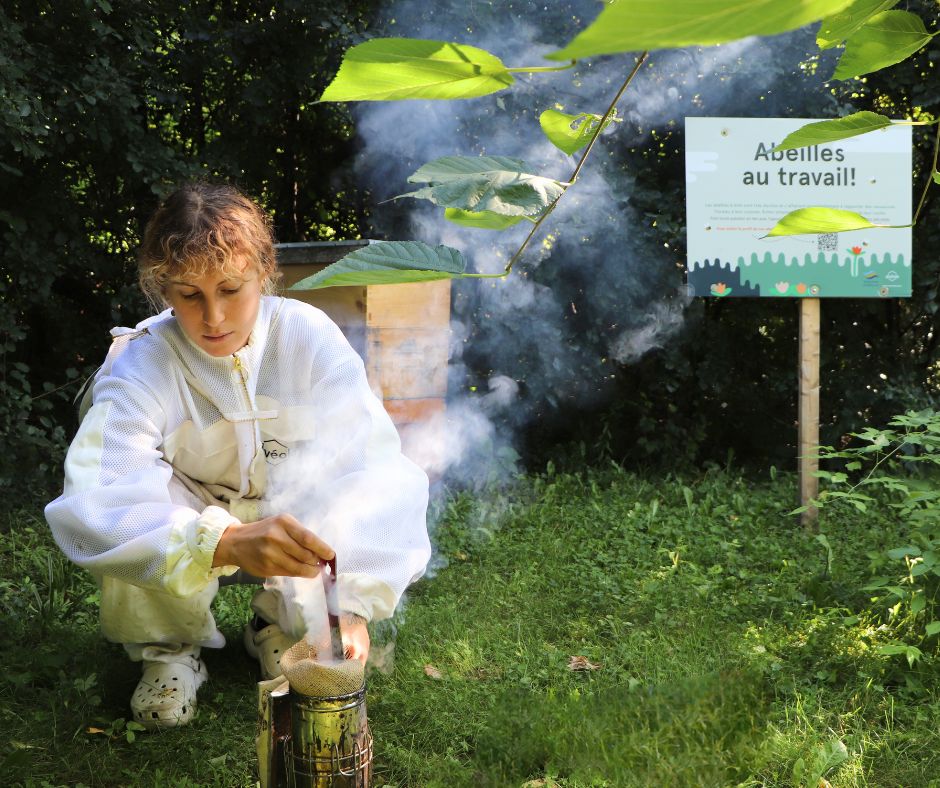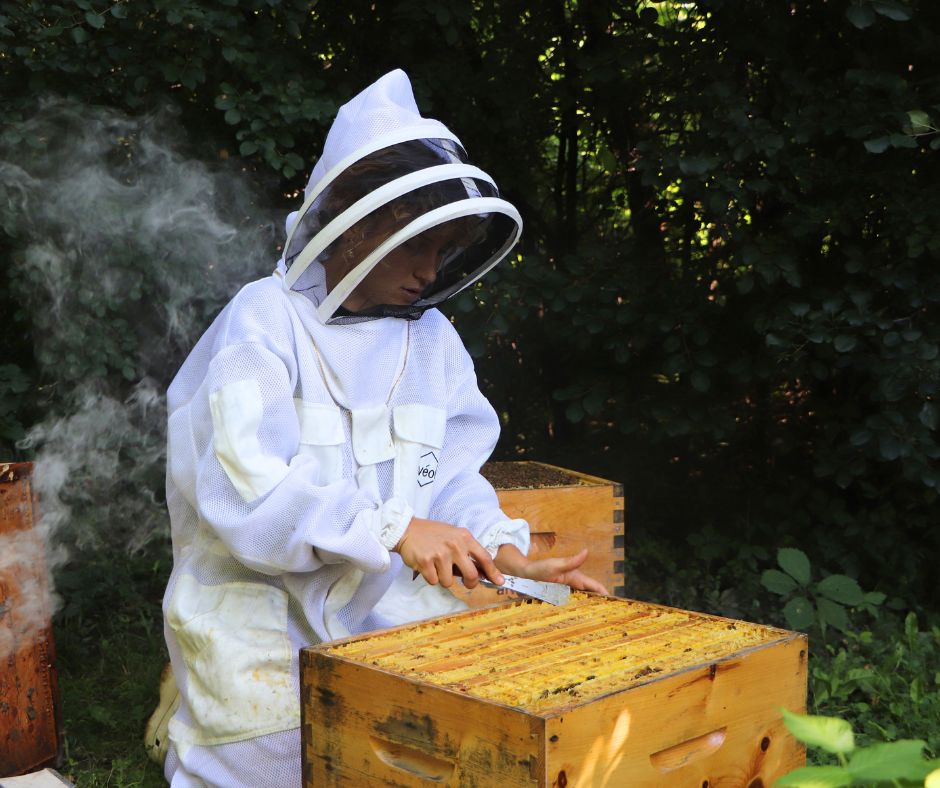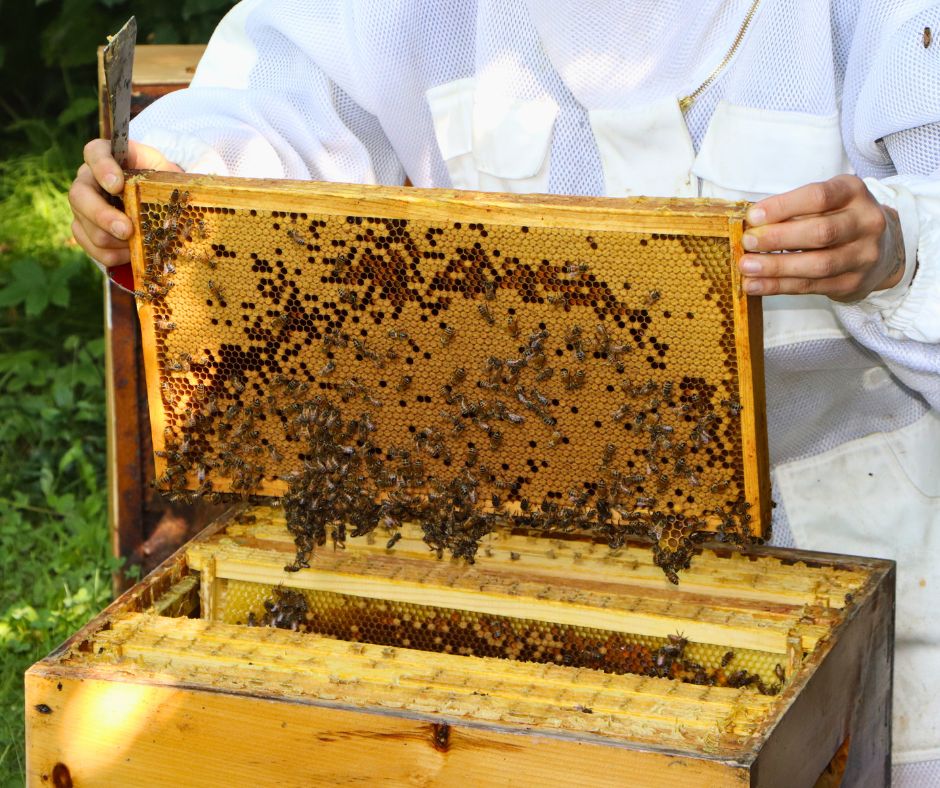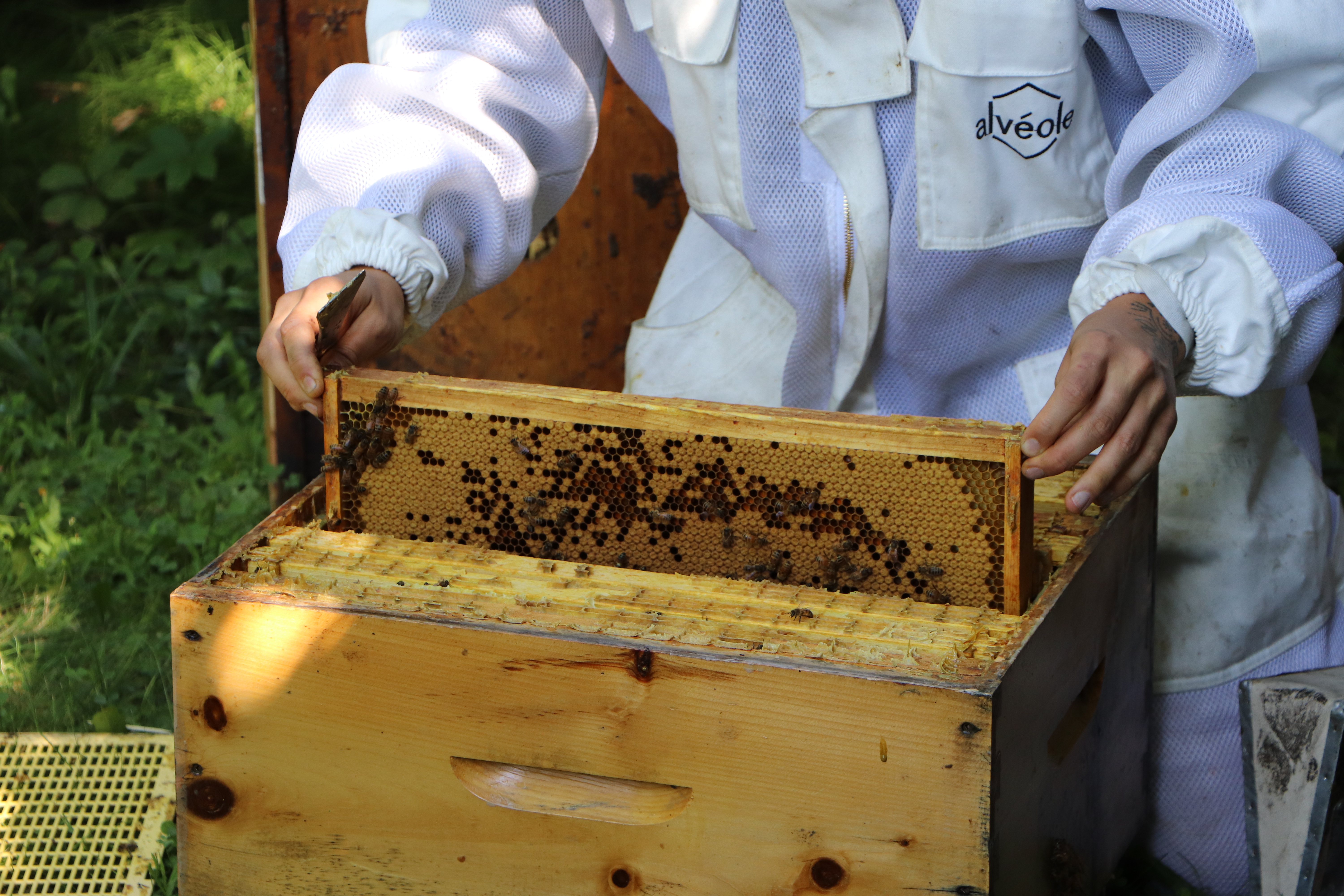Alerts |
2025-01-01
Règlement sur le stationnement de nuit - Hiver 2024-2025Règlement sur le stationnement de nuit - Hiver 2024-2025 |


Urban Beekeeping
Urban Beekeeping
Urban beekeeping
It's Buzzing in Sainte-Anne-de-Bellevue
By installing a first beehive on the roof of Centre Harpell back in 2017, Sainte-Anne-de-Bellevue was actively taking part in sustainable development.
Urban beekeeping contributes to increasing local honey production, the pollination and provides a greener urban setting. Its mission is to protect the bees that have been in decline all over the world, while increasing the general population’s awareness about their essential role for the environment.
The bee is a pollinator insect that plays a major role in the production of fruit, vegetables and nuts: one third of our food supply relies on their pollination!
In 2019, we added a second hive at the same location to further increase the City's involvement in the clean-up of the region's ecosystem and food chain.
To see the evolution of our hive and for a wide range of information on bees and their indispensable contribution to our environment, visit our page on Alvéole's website.
 |
 |
 |
Alvéole

Their goal? Change the urban landscape of Canadian cities, one beehive at a time.
The Beekeeper’s Seasonal Calendar
As a beekeeper, your objective is to make sure that your beehives are healthy. The tasks in a season accumulate rapidly, and in order to work effectively and be ahead of the game, what better than a memory aid that keeps track of the key steps to a successful season?
The Alvéole team comes to prepare the hives each spring, in April. After winter, it's time to unpack the hive to make sure the colony has had a good winter and has enough space to grow. They also make sure that the hive components are in good condition and that the bees have enough resources until the first blooms.
The team visits regularly during the active bee season to ensure the essential steps to beekeeping are followed:
From the first blooms, divide the hive to rebalance the amount of resources and brood. This essential step helps prevent a phenomenon to avoid in urban areas: swarming.
It is essential to find a suitable place for a colony, taking into account geographic location, traffic, sun, wind and access to water. The bees must be placed in the ideal location and given time to discover their new environment.
The colony is growing rapidly at this time of the year. It is therefore essential to thoroughly inspect the hive to ensure that the queen has enough room to lay, that there is a good balance of resources and that the colony does not intend to breed.
Preventing swarming is a crucial step in urban beekeeping. It must be ensured that the colony did not produce royal cells. If this is the case, it is necessary to act quickly and to use an advanced method of management of the swarming to curb this will.
The addition of the queen gate is an important step in anticipation of the honey harvest. From four to eight weeks before harvest, the queen should be found among the two brooders and sequestered in the bottom rise, placing the queen gate between the two floors. It is also essential to know how to install the bee hunt in time and place, 7 days before harvest!
The colony is growing rapidly at this time of the year. It is therefore essential to thoroughly inspect the hive to ensure that the queen has enough room to lay, that there is a good balance of resources and that the colony does not intend to breed.
Honey harvesting involves several stages: the recovery of mature frames, the brushing of late bees and the transport of honey frames to extraction. In addition, it is necessary to bring back the hive to a single increase in preparation for the winter and to treat the colony against the varroa without delay. The treatment of the colony is included in this visit.
Once the harvest of the rises and frames of honey is over, the time has come to extract the precious nectar stored in the cells. The process is simple, but still requires some specialized equipment: tray and forks to uncap, centrifugal extractor, filters, maturation boilers and pots. You can do it at home without problems, but book this visit if you prefer to let our team take care of the extraction process in our certified honey house.
Feeding the colony is essential: without feeding, bees simply do not have enough resources to spend the winter. In addition, it is important to feed the bees with sugar syrup, which is much easier to digest. This syrup is included in this tour. This is also the time to set up the inlet reducer and the drawer under the base of the hive.
As temperatures drop below 10 degrees Celsius, the hive must be protected from cold and high winds with an insulating material and styrofoam lid. All material required for isolation is included in this tour.
Honey and more!
One hive produces about 10 to 15 kg of honey annually!
The honey from our hives is harvested in September and comes back to us later in pretty jars with the City's logo on them.
In addition to honey, our hives produce three other products, hand-crafted, with love and respect for the health of bees:
- Lip Balm (beeswax and organic sunflower oil)
- Soap (honeysuckle, linden & honey)
- Beeswax Candle
Some Facts...
Stings
- The honey bee is very little interested in humans. Its daily quest: bring nectar, pollen, resin or water to its colony to ensure its development.
- Bees only bite when they feel their colony is threatened. This is not surprising: unlike wasps, bees die quickly when biting, since they leave their sting and part of their abdomen at the site of the sting.
- Unless there is aggression towards it (or its colony), the bee has no reason to sting.
- At Alvéole, we work with an Italian bee variety specially selected for its pleasing temperament. We have been installing hives in hundreds of companies, schools and homes for years and we have never had any major stakes related to bee stings. Obviously, the possibility of an injection can never be entirely dismissed, but the chances remain very low.
- Italian bees are particularly sweet and perfect for populating an apiary in densely populated areas. This is also why urban beekeepers carry little protection.
- Many people say that they have had a bee sting, but they swear they did not see a sting in their skin. It was probably a wasp sting, since they have a very smooth sting that can enter and leave their abdomen as they please.
Hive
- At the peak of summer, a hive can hold up to 50,000 bees.
- About 90% of the bees in the hive are females (the workers), while 10% of the bees are actually males (the drones).
- The alveoli are literally in the heart of the hive. These small hexagonal cells are built exclusively in wax. They serve to store all the essential elements of the colony and its development: the resources (nectar, honey and pollen) and the brood (eggs, larvae and brood).
Members of the hive
- Each hive has only one queen. Her Majesty can live up to five years in the best conditions. She needs the support of a horde of workers to help her feed, hydrate and clean herself, being too busy laying up to 2,000 eggs a day.
- The males of the hive, the drones, have no sting; they have a reproductive system instead. Instead of foraging for resources, the drones are waiting for a virgin queen to fertilize from a nearby hive.
- In the hive, the worker occupies several roles during her short life, which lasts, on average, 30 to 45 days only: nurse, cleaner, ventilator, guardian, waxer and forager.
Winter
- During the winter, the bees stay warm in their hive, where they maintain an internal temperature of 35 degrees Celsius! To do this, they form a tight cluster around their queen and keep warm by contracting their muscles.
- After winter, much like perennials, strong hives should be divided into several small hives. The goal: to rebalance the strength of hives and the size of their population.
Cohabitation in an urban environment
- Bees are still foraging for exclusive nectar and pollen, as opposed to wasps, the omnivorous insects that feed their young with animal protein.
- It is simple, easy and natural to live with bees in the city. After all, honey bees are just one of many species of pollinators with which we share urban space (eg butterflies, drones and wild bees).
- Cities are oases for pollinators because of the lack of pesticides, the abundance of floral resources, the temperate climate and the availability of water sources.
Interesting facts
- The workers dedicate their lives to the service of their colony and never leave it for another.
- Bees perceive colors very well, especially blue, mauve and purple.
- The more mature workers become, the more responsibilities they have. They occupy all the roles, in turn, within their colony.
- Each bee lives from 3 to 6 weeks in summer and 3 to 6 months in winter.
- Bees communicate with each other thanks to pheromones, which are, in a way, odors that cause them to behave in a specific way.
- It is estimated that bees must consume 8 kilos of honey to produce a single kilo of wax.
Composition
- Bees feed on the nectar of flowers and plants that are within 5 km of their hive. They add enzymes and reduce the moisture content of the nectar, before storing it all in sealed cells.
- Each honey is in a way a reflection of the ecosystem that surrounds it, a kaleidoscope of flavors from the flowers visited by bees.
Crystallization and conservation
- All homemade and unpasteurized honeys crystallize. Crystallization is a normal, natural and inevitable process - not a sign of product deterioration.
- A crystallized honey retains its flavor and all its properties (enzymes, proteins and vitamins), but it simply changes texture.
- Honey can be stored indefinitely at room temperature because of its high sugar content.
Interesting facts
- Bees roam the equivalent of four times around the earth to produce each kilogram of honey.
- Bees visit up to 4,500,000 flowers to produce each kilo of honey.
- Each bee will produce about 1/8 teaspoon of honey during its lifetime.
Advantages
- The installation of an apiary in a city has the potential to contribute to environmental education forcity dwellers, in addition to having a positive impact on the surrounding environment and ecosystem.
- The benefits of urban beekeeping are numerous: the practice brings together city dwellers around a project that allows the valorization of an unused space, making it possible to highlight a host of issues related to the environment, industrial agriculture, pollination and greening, while producing a local food.
Origin
- Before being recovered by urban dwellers, beekeeping was an agricultural practice focused on the production of honey, with its economic imperatives. Today, urban apiculture responds to more and more objectives that go far beyond this idea of productivity and makes it possible to sensitize urban dwellers to food production and the issues related to conventional agriculture.
- Some pioneering initiatives have allowed urban beekeeping to emerge. This is the case of the apiary of the Paris Opera, installed in 1982. However, an apiary-school exists in the jardin du Luxembourg since 1856.
Honey bees
- Because of their numbers, honey bees are excellent pollinators. Several types of agricultural production rely entirely on beekeepers to move with their hives to pollinate their crops, such as conventional blueberries and orchards.
Wild bees
- The bee used in beekeeping is not native to North American territory. However, hundreds of species have evolved here, in our ecosystems, along with our native flora: solitary, wild and social bees, such as bees of the genera Megachile, Osmia, Halictus and Andrena, as well as certain types of drones.
Decline of pollinators
- Bee, butterfly, bumblebee and other pollinator populations are declining significantly around the world. Like honey bees, these insects face threats from industrial agriculture (such as pesticide use and habitat loss) and climate change.
- To stop the loss of pollinators, conventional farming practices must radically change in favor of ecological practices, such as synthetic pesticide-free cultivation, crop rotation, habitat creation and the preservation of natural and uncontaminated water sources. .
Role in food production
- Pollinators are responsible for pollinating more than 130 crops of fruits and vegetables worldwide, nearly one-third of all our food.
- Almonds, cranberries, apples, blueberries, broccoli, cauliflower, celery, asparagus, avocados, legumes: these are some examples of crops that depend 100% on the pollination of insects to be productive.
- The decline of pollinators coincides with the increase in agricultural demand, resulting in an increase in the price of many foods.
- Since 2013, the Alvéole social enterprise has been installing beehives in North America’s largest cities, raising awareness among thousands of businesses, organizations, schools and families about issues affecting bees, such as use of pesticides, monocultures and loss of biodiversity.
- Bees are safe enough for schools: Alvéole has implemented more than 100 beekeeping projects in Canadian schools to educate youth about food production and the importance of biodiversity.
- More than 500 companies in North America have installed beehives on their roofs or grounds in partnership with Alvéole.
- Nearly 96% of corporate customers continue the beekeeping adventure with Alvéole year after year.
- Alvéole estimates that it has raised more than 25,000 people to the environment and biodiversity, through its educational activities, since its founding in 2013.


